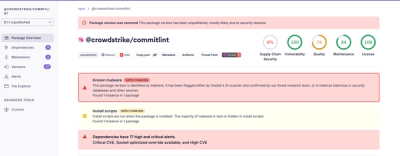
Research
Malicious fezbox npm Package Steals Browser Passwords from Cookies via Innovative QR Code Steganographic Technique
A malicious package uses a QR code as steganography in an innovative technique.
ABuS is a script for backing up (and restoring) your files to a local disk.
The backups are encrypted, compressed, and deduplicated. It is assumed that another program (e.g. rsync) is used to make off-site copies of the backups (see below).
Content of this document:
Caveats_
Installation_
Documentation_
Off-site copies_Index Database_Configuration file_Command line switches_History_
ABuS only works on Windows.
ABuS only backs up file content. In particular the backups do not include permissions, symbolic links, hard links, or special files.
If you use ABuS in anger (inspite of the lack of guarantees in the licence), please pay particular attention to what the documentation below says about
password optionInstall Python 3.6 from python.org
From the command line, "as administrator" if python has been installed "for all users"::
c:\path\to\python36\scripts\pip install abus
Create minimal config file, e.g.::
logfile c:/my/home/abus.log archive e:/backups password password1234 just kidding! [include] c:/my/home
Initialise the backup directory and the index database with::
c:\path\to\python36\scripts\abus.exe -f c:/my/home/abus.cfg --init
Add to Task Scheduler::
c:\path\to\python36\scripts\abus.exe -f c:/my/home/abus.cfg --backup
If there are any problems that prevent ABuS from getting as far as opening the log file (and Windows permissions can cause many such problems), then use cmd.exe to allow redirection::
cmd /c c:\path\to\python36\scripts\abus.exe -f c:/my/home/abus.cfg --backup
c:\abus.err 2>&1
Overview ++++++++
ABuS is a single script for handling backups. Its command line parameters determine whether the backups are to be created, listed, or restored. The backups are stored in subdirectories of the backup directory which must be on a local filesystem. For off-site copies another program is to be used, for example rsync.
Warning: Off-site copies must be made correctly to minimise the risk of propagating any local corruption (see below).
A configuration file is used to point to the backup directory, define the backup set, and some options. ABuS finds the configuration file either via a command line parameter or an environment variable.
Purging +++++++
Old backup files are deleted after every backup. In order to determine which backups are deleted, time is divided into slots and only the latest version of a file in each slot is retained while the others are subject to purging. As slots get old they are combined into bigger slots.
The configuration file defines the slot sizes using freq/age pairs of numbers, which define that 1 version in freq days is to be retained for backups up to age days old.
For example, if the retention values are 1 7, 7 30, 28 150, then for each file one version a day is kept from the versions that are up to 7 days old, one a week is kept for versions up to 30 days old, and one every four weeks is kept up to 150 days.
There is also a single slot older than the highest age defined, called "slot 0". In the example above one file older than 150 days will be kept as well.
The time that a file deletion is detected (i.e. a file previously backed up no longer exists) must fall into slot 0 before the last backup of the file is purged. E.g. with default retention values, 150 days after a file is deleted its backups will be purged.
Restoring +++++++++
Backup files can be restored from the backups using the --restore command line option.
By default the backups to be restored are the latest version of each known file.
The set of files can be restricted using "glob" positional arguments. As for
exclusions, a * matches the directory separator. A backup is restored if its
path matches any of the glob arguments.
Slashes and backslashes can be used interchangeably.
With the -d option the latest version of each backup before the given time is
restored rather than the latest version before now.
With -a all versions (before the cut-off time) are restored and a timestamp is
added to the restored files' names.
After the set of restore files has been determined, ABuS removes the common part of their paths and creates the remaining relative paths in the current directory. E.g. if these the files were to be restored::
c:/home/project/file_a c:/home/project/src/file_b c:/home/project/src/file_c
Then they would be restored as::
./file_a ./src/file_b ./src/file_c
Files that have been deleted at the cut-off time are not restored. Note, however, that ABuS does not track historic deletions; for example, assume a certain file was last changed on Monday, deleted on Tuesday, and recreated on Wednesday. A restore with an end-of-Tuesday cut-off would restore the Monday version.
The --listing option lists backed up files. It takes the same options as
--restore and lists exactly those backup versions that would be restored.
The --listing option is implied if any of the restore filters are used without a
--restore.
Off-site copies +++++++++++++++
ABuS only backs up to local filesystems. This means that the backups themselves are at risk of corruption, for example from ramsomware. It is important that another copy of the backup is made and that it fulfills these criteria:
The following is an example of an rsync command that would copy the local backup directory to an off-site location::
rsync --recursive --ignore-existing
--exclude index.sl3 --exclude '*.part'
/my/local/backups/ me@offsite:/backups/
index.sl3 need not be transferred because it changes and it can be rebuilt
from the static files. Files with .part extension are backup files that are
currently being written and will be renamed once complete. Excluding them
ensures that incomplete backup files are not transferred.
Since it is not advisable to propagate changed files - and therefor deletions - to the off-site copy of the backup files, these must be purged independently.
To that end ABuS creates a content file in the backup directory which lists all backup files. The content file is compressed with gzip and its file name is that of the last backup run with a .gz extension. When such a file is written, the previous one is removed. Since the run names are basically ISO dates, a script on the off-site server can easily pick up the latest and remove all backup files that are not listed in it.
N.B.: The following is only an outline of such a script to convey the idea. You must not use it without checking it first::
cd .../offsite-copy keep_list=$(ls *.gz | tail -n 1) (find -type f -printf '%P\n'; zcat $keep_list $keep_list) | sort | uniq -u >/tmp/remove [[ $(wc -l /tmp/remove) -lt 50 ]] || exit # sanity check xargs rm </tmp/remove
Index Database ++++++++++++++
The index database duplicates backup meta data for quicker access. Since it is changed during normal operation, it cannot be included in the off-site copy. There are therefore command line options to rebuild the index database from the backup files.
Important: Before rebuilding the index database, check the integrity of the content file, for example by comparing it with its off-site copy.
It is important that the index database be not rebuilt from corrupt backup data.
Since the backup files are encrypted, corruption would normally show,
but a missing backup file would not.
The integrity of the content file (see Off-site purging_ above),
which is not encrypted,
must therefore be ascertained before rebuilding the index database.
Configuration file ++++++++++++++++++
The file has three sections
ABuS uses slashes as path separators internally. All filenames given in the config file or on the command line may use backslashes or slashes; all backslashes are converted to slashes.
The first word of each line is a parameter name, the following words form the value. Leading and trailing spaces are trimmed while spaces within the value are preserved.
logfile
Specifies the path of a file to which all log entries are made. The parameter
should be given first so that any subsequent errors in the configuration can
be reported to the log.
archive
Specifies the path to the root backup directory containing all backup files.
indexdb
Specifies the path to the index database. By default this is index.sl3
inside the backup directory, but it might be preferable to place it on a
faster disk, for example.
password
Specifies the encryption password to be used for all backup files. The
encryption allows copying the backup archive to an off-site location.
N.B.: Make sure the the config file is UTF-8 encoded, so that any special characters in the password are interpreted in a well-defined way.
N.B.: Once a backup has been created the password must not be changed, since ABuS does no keep track of which backup files use which password (obviously). If you want to change the password, you need to create a new archive.
retain
Specifies how old backups are pruned. The keyword is followed by a
space-separated list of numbers forming freq and age pairs, meaning:
"keep one backup per freq days for files up to age days old". See
Purging_ above.
The age values must not repeat and the freq values must be multiples of
each other. freq can be a float, e.g. 0.25 for six hours.
The retention values default to::
retain 1 7 56 150
compressed_extensions
Space-separated list of file extensions that ABuS assumes belong to files
that are already compressed. All other files will be compressed before they
are encrypted.
The extensions are shell global patterns and are matched ignoring case. Thus
jp*g is matched by jpg, JPG, and jpeg;
* would switch compression off completely.
Defaults to:
7z arj avi bz2 flac gif gz jar jpeg jpg lz lzmo lzo
mov mp3 mp4 png rar tgz tif tiff wma xz zip
threads
Sets the maximum number simultaneous backups in order to limit the strain on CPU,
IO, and memory. The default value is one less than the number of hardware threads
on the system, but at most 8.
A line containing the header [include] starts the inclusion section,
each line of which is a directory path which will be backed up recursively.
There must be at least one inclusion.
A line containing the header [exclude] starts the exclusion section,
each line of which is a shell global pattern. All file paths that would be
backed up (or directory paths that would be searched for files) are skipped if
they match any of the patterns.
A * in the patterns also matches the directory separators.
*.bak ignores any file with the extension .bak;
*/~* ignores any file or directory starting with a tilde.
Command line switches +++++++++++++++++++++
Run abus --help for detailed command line switch help.
v11 2018-06-21
v10 2018-06-17
v9 2017-12-31
v8 (beta) 2017-12-10
v7 (beta) 2017-11-19
v6 (beta) 2017-11-12
v5 (beta) 2017-11-05
v4 (alpha) 2017-10-22
v3 (alpha) 2017-10-15
v2 (alpha) 2017-10-07
v1 (alpha) 2017-10-04
.. vim:tw=80:ft=rst
FAQs
Abingdon Backup Script
We found that abus demonstrated a healthy version release cadence and project activity because the last version was released less than a year ago. It has 1 open source maintainer collaborating on the project.
Did you know?

Socket for GitHub automatically highlights issues in each pull request and monitors the health of all your open source dependencies. Discover the contents of your packages and block harmful activity before you install or update your dependencies.

Research
A malicious package uses a QR code as steganography in an innovative technique.

Research
/Security News
Socket identified 80 fake candidates targeting engineering roles, including suspected North Korean operators, exposing the new reality of hiring as a security function.

Application Security
/Research
/Security News
Socket detected multiple compromised CrowdStrike npm packages, continuing the "Shai-Hulud" supply chain attack that has now impacted nearly 500 packages.